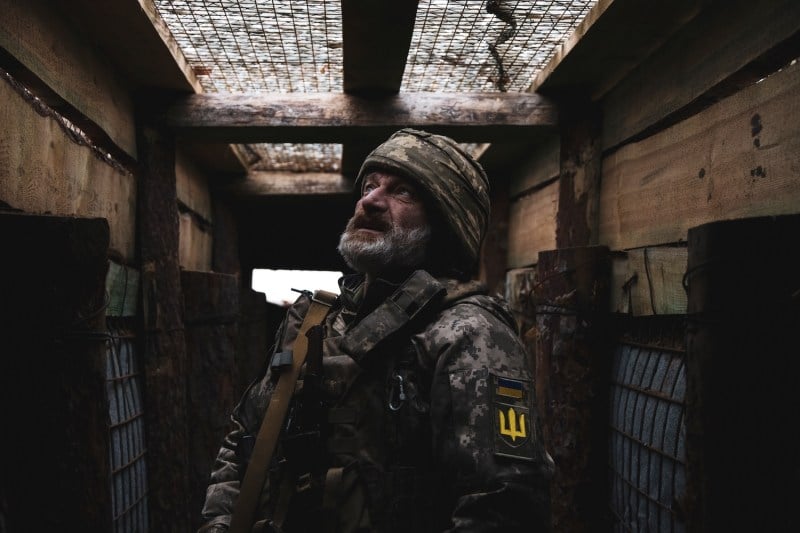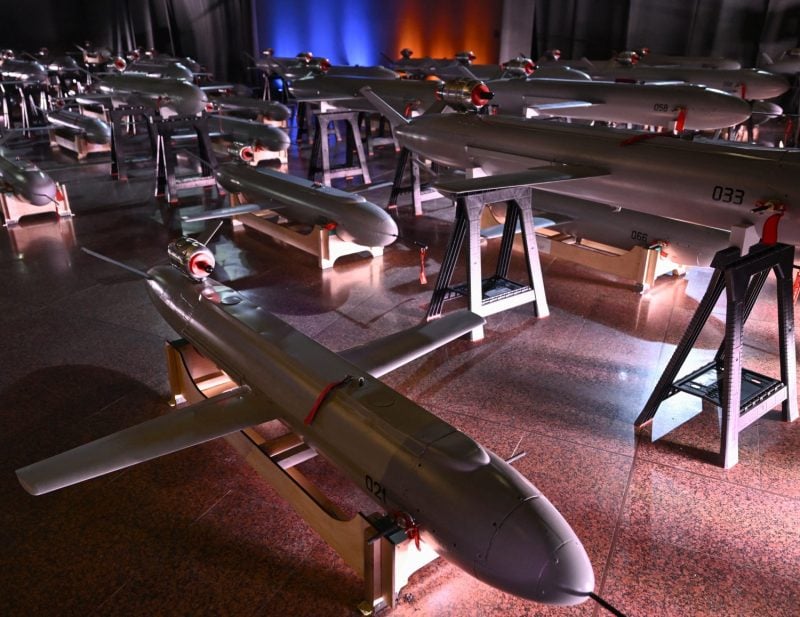The Only Viable Peace for Ukraine

The Only Viable Peace for Ukraine
Neutrality in exchange for occupied territory—with an ironclad Western defense guarantee if Russia attacks again—is the way forward.
The commander of a mobile firing team in a trench near Zaporizhzhia, Ukraine on Dec. 2, 2024. Nikoletta Stoyanova/Getty Images
It was exactly eight years ago when Ukrainian political elites faced a similar question to today: What to do if the United States elected a president who wants a deal with Russia on Ukraine?
At the time, I proposed ideas including a U.S.-Russia mutually binding security guarantee, a U.N. international transitional administration for territories Kyiv didn’t control, and an approach resembling Northern Ireland’s Good Friday Agreement giving self-governance to Crimea with formal Ukrainian sovereignty over the peninsula. Instead of a constructive internal discussion, these ideas were denounced by Ukrainian authorities and media, and Ukraine’s security service even announced a treason case against me.
It was exactly eight years ago when Ukrainian political elites faced a similar question to today: What to do if the United States elected a president who wants a deal with Russia on Ukraine?
At the time, I proposed ideas including a U.S.-Russia mutually binding security guarantee, a U.N. international transitional administration for territories Kyiv didn’t control, and an approach resembling Northern Ireland’s Good Friday Agreement giving self-governance to Crimea with formal Ukrainian sovereignty over the peninsula. Instead of a constructive internal discussion, these ideas were denounced by Ukrainian authorities and media, and Ukraine’s security service even announced a treason case against me.
Now, Donald Trump is back in the White House, Russian President Vladimir Putin is on the rise, and Ukraine is in ruins—losing territory every day, with a demoralized society, destroyed infrastructure, and internal divisions deeper than any time in our history. Ukrainians must now draw conclusions from the mistakes that have been made and save what is still 80 percent of our territory.
Many people around the world may dislike Trump, but for the majority of Ukrainians Trump is a hope for peace. Ukrainian elites must stop fantasizing and drawing lines in the sand while Ukrainians suffer and die every day.
A realistic and professionally prepared settlement plan is needed, not a shopping list. It will be much worse than what I proposed in 2016, worse than the Minsk agreements or the stillborn Istanbul proposal of 2022, but better than what Washington and Moscow can agree on without us at the table—or if the current war of attrition fully destroys Ukraine as a state and a nation.
Russia will certainly take advantage of its recent successes on the battlefield. But Russia has also learned from its mistakes. Russia was not prepared to fight such a prolonged war and has paid a high price. If Putin ever believed in his fantastical 2021 narrative about brotherly ties between Russia and Ukraine, he has now witnessed that his sources and intelligence services lied to him; Ukrainians have made clear that we can and will resist.
The key task for Ukrainian diplomats now is to ensure that there will be enough Ukrainians left in the country and that the conditions of a cease-fire or peace discourage Russia from attacking Ukraine again. And Trump can help.
Recently, Putin stated that Russia would accept Ukraine’s territorial integrity based on its 1991 borders only in the event of Ukrainian neutrality. It follows, then, that Moscow should now return all Ukrainian territory Russia has occupied if Ukraine declares neutrality. Alternatively, if Putin still controls even one inch of Ukrainian territory or attempts to retake any sovereign Ukrainian territory, he will trigger a Western defense guarantee. Such a stark choice can help frame negotiations.
The key element of a new deal should be that Ukraine’s neutrality can remain only as long as Russia does not violate Ukraine’s territorial integrity: In case of any aggressive action from the Russian side, Ukraine automatically receives direct U.S. military protection.
There must be a clear agreement between all sides, including the United States, that if Russia attacks again, an international coalition led by the United States will intervene directly with their militaries.
In other words, Ukraine would receive even stronger security guarantees than NATO’s Article 5 while not becoming a formal NATO member. It settles both Ukraine’s demand for security guarantees and the Russian demand for NATO non-enlargement. Ukraine remains neutral only as long as Russia does not attack. If Trump resolves this conflict—one of the most vexing geopolitical problems of our era—he might even get a Nobel Peace Prize.
Such a peace deal would remove the basic roots of the conflict and open ways to renew trade and economic links. But what if Russia refuses to return occupied territories to Ukraine?
Russia must be convinced by Washington and other international actors that if a peace agreement with Ukraine is reached, its gains will outweigh its losses. The deal will give Moscow sufficient political and economic benefits, while refusal will bring growing risks and isolation. If Russia refuses to return occupied land in a mutually acceptable way, then it must be aware that no one ever will recognize Russian sovereignty over these territories.
Russia will be always isolated with sanctions, and its trade and freedom of movement for its leaders and citizens will be curtailed. Ukraine will not be neutral if a part of its territory is occupied and there is no realistic roadmap to renew its integrity. So, if NATO membership is off the table, as U.S. officials’ recent comments suggest, then direct U.S. security guarantees must be adopted if Russia refuses the peace.
China, India, and other global south countries will most likely support this sort of proposal. China has already expressed respect for Ukraine’s internationally recognized borders while also demonstrating sympathy for Russian concerns on the dangers of Ukraine joining NATO. So, the proposed peace framework largely fits China’s idea of a peace plan. If China stands together with the United States behind such a proposal, Russia will have difficulties refusing it. Moreover, India, Brazil, and South Africa would likely also support conflict resolution on this basis.
Freezing the conflict will be difficult given what’s happened in the last three years. The contact line will be a source of threats, danger, criminal activities, and trafficking.
Other issues will also be on the agenda—like reconstruction from the Ukrainian side or language status from the Russian side. There should be a new Helsinki Final Act to ensure inviolability of borders and security reassurances to all the other countries of the continent.
The U.N. Security Council reform must finally move forward to ensure that no permanent member can start a war without punishment. And Ukraine will have also to make internal changes long overdue like returning to the rule of law, ending corruption, giving more rights to regions, respecting local self-governance, adopting a new constitution with efficient checks and balances, respecting property rights, and allowing freedom to choose one’s language and place of worship. But these are all a sideshow if there is a core agreement on neutrality and NATO.
When politicians turn from slogans to practice, they will discover an unpleasant truth. In the best-case scenario, it will be a very long time before people who remained in Ukraine will see a peace dividend, let alone full-fledged EU accession. Few will return to the country destroyed by the war with such a large demilitarized zone and with significant threat of a new attack. Likewise, few foreign companies will dare to invest.
Trump must therefore start with the goal of completely resetting the Euro-Atlantic security architecture with an ambitious peace deal that gives everyone in the region confidence in the future.
The rest should be done by Ukrainians themselves. The nation has to finally understand that it has to rely on itself to have a strong, resilient, and viable state ensuring its future security and protecting its borders and territorial integrity.
Vasyl Filipchuk is a senior advisor at the International Centre for Policy Studies and served as a Ukrainian diplomat from 1997 to 2012.
More from Foreign Policy
-

Russian President Vladimir Putin looks on during a press conference after meeting with French President in Moscow, on February 7, 2022. The Domino Theory Is Coming for Putin
A series of setbacks for Russia is only gaining momentum.
-

The container ship Gunde Maersk sits docked at the Port of Oakland on June 24, 2024 in Oakland, California. How Denmark Can Hit Back Against Trump on Greenland
The White House is threatening a close ally with a trade war or worse—but Copenhagen has leverage that could inflict instant pain on the U.S. economy.
-

Donald Trump speaks during an event commemorating the 400th Anniversary of the First Representative Legislative Assembly in Jamestown, Virginia on July 30, 2019. This Could Be ‘Peak Trump’
His return to power has been impressive—but the hard work is about to begin.
-

US Secretary of State Marco Rubio greets employees at the State Department in Washington, DC, on January 21, 2025. The National Security Establishment Needs Working-Class Americans
President Trump has an opportunity to unleash underutilized talent in tackling dangers at home and abroad.










Join the Conversation
Commenting on this and other recent articles is just one benefit of a Foreign Policy subscription.
Already a subscriber?
.
Subscribe
Subscribe
View Comments
Join the Conversation
Join the conversation on this and other recent Foreign Policy articles when you subscribe now.
Subscribe
Subscribe
Not your account?
View Comments
Join the Conversation
Please follow our comment guidelines, stay on topic, and be civil, courteous, and respectful of others’ beliefs.
Change your username |
Log out
Change your username:
CANCEL
Confirm your username to get started.
The default username below has been generated using the first name and last initial on your FP subscriber account. Usernames may be updated at any time and must not contain inappropriate or offensive language.